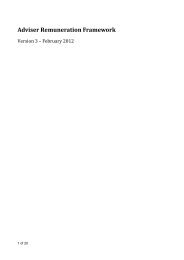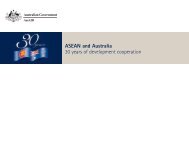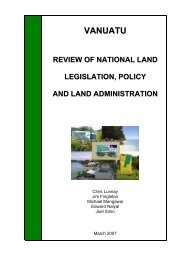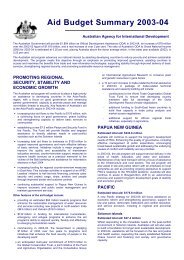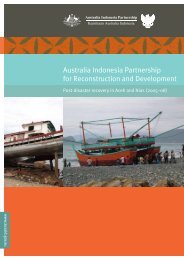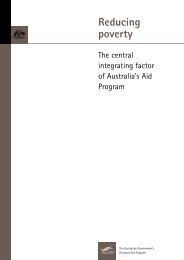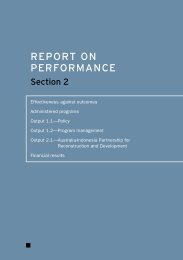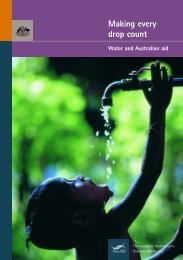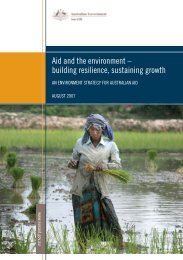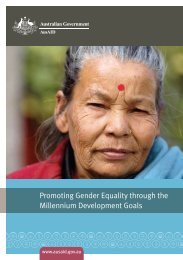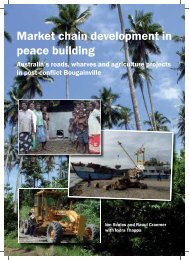Australian Aid to PNG - AusAID
Australian Aid to PNG - AusAID
Australian Aid to PNG - AusAID
Create successful ePaper yourself
Turn your PDF publications into a flip-book with our unique Google optimized e-Paper software.
Unfortunately a shortage of reliable data prevents defensible statistical analysisof the relative importance of these broad determinants of growth. Nonethelesssome useful observations can be made.The first point <strong>to</strong> note is that the growth in the non-mining economy sinceindependence is largely accounted for by population growth. Overall theeconomy has only been growing at the rate of the population, and there hasbeen little or no growth in real per capita incomes. This observation confinesthe assessment of the growth performance. There is no need <strong>to</strong> try anddisentangle the contribution of technological change, improved human capital,the policy environment, etc. At an aggregate level there is simply no growth inper capita incomes <strong>to</strong> explain.A second key point is the apparent absence of a growth dividend fromimproved education and health. The improved social indica<strong>to</strong>rs presented abovepoint <strong>to</strong> an improved quality of the human capital input (ie, a better educatedand healthier population). Improvements in the quality of human capital shouldresult in growth, but this does not appear <strong>to</strong> have been the case in Papua NewGuinea. It appears reasonable <strong>to</strong> conclude that the potential offered by theimprovement in human capital has been stifled by other constraints.Or in other words, the aggregate data suggest that something is holding theeconomy back. But what are these constraints? The aggregate data are notsufficiently rich <strong>to</strong> allow a rigorous identification of the constraints that matterthe most. But the most likely explanation is that realisation of the benefits ofimproved human capital has been constrained by weaknesses in the policy andinstitutional environment and/or perhaps a shortage of physical capital, notablyphysical infrastructure. In this respect it certainly seems reasonable <strong>to</strong> arguethat key constraints are likely <strong>to</strong> include the adverse impacts of the ‘dutchdisease’, effects associated with a booming mining sec<strong>to</strong>r and substantial aid,the law and order problem, the adverse effect on incentives of certain aspectsof the culture and the macroeconomic instability created by poor fiscalmanagement are key fac<strong>to</strong>rs.It is also likely that private investment in physical capital has been held backby similar constraints. The poor investment record would have had the adverseflow-on effect of reducing opportunities for new technology <strong>to</strong> be introduced,further hindering growth.In summary, unfortunately for Papua New Guinea it is not a case of explainingwhy growth has occurred, but of explaining why the growth outcome has beenweak. And these explanations inevitably point back <strong>to</strong> the state of the policyand institutional environment and public infrastructure.18 The Contribution of <strong>Australian</strong> <strong>Aid</strong> <strong>to</strong> Papua New Guinea’s Development 1975–2000



